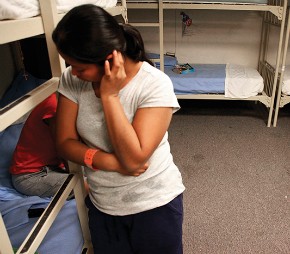Credible fears: Central American women seek asylum
Last year, the U.S. took thousands of "family units" into custody at the southern border. Nearly every woman cites violence as the reason she fled.

A tiny girl about ten years old, with a ponytail and gold loop earrings, was sitting in the defendant’s chair in Judge Mimi Tsankov’s Denver courtroom. Tsankov is a U.S. immigration judge in one of the nation’s 59 immigration courts.
“How does the defendant plead?” Judge Tsankov asked.
The child’s lawyer answered for her: “The defendant concedes the one charge, Your Honor.”
“The defendant is declared removable as charged. To what country does the defendant request removal?”
“The defendant does not designate a country.”
“To what country does the department deem?”
“The department deems Guatemala, Your Honor,” said John Canedy, the lawyer for the Department of Homeland Security, looking down at his notes.
“So moved,” said Judge Tsankov.
I had never seen removal proceedings before. Is that it? I wondered. Is the child going to be sent back to Guatemala? Why is everyone acting so nonchalant about it?
Then the judge continued. “What form of relief is the defendant seeking?”
“The defendant is applying as a UAC for SIJS, Your Honor.” The initials UAC stand for “unaccompanied alien child” and SIJS means “special immigrant juvenile status.” The child was applying for special protection as an abandoned, abused, or neglected immigrant child.
Next to me, in the room filled with women and children, I noticed a woman dressed in a suit introducing herself to a woman holding a curly haired toddler. “I’m Francesca Ramos,” she said in a whisper. “Karen,” the other woman whispered back. They shook hands.
Read our latest issue or browse back issues.
When it was Karen’s turn before the judge, Ramos went forward with her. Ramos told the judge that Karen had not received a “notice to appear” and was unprepared to respond to the summons. “If we could have just five minutes, we could file some of the paperwork.”
Judge Tsankov ordered a five-minute break and left the room. After the break, Karen and Ramos conceded the charge that Karen was in the U.S. without permission, and Canedy designated El Salvador as the county for removal.
The judge corrected him. “It says Guatemala here.”
“Sorry,” he said.
Ramos indicated that Karen was seeking asylum and appealed for more time to prepare the application. “I’ve only recently been retained as her counsel,” Ramos told the judge. The motion was granted, and the court moved on to the next case.
All the cases Judge Tsankov heard that morning involved unaccompanied children or women and children who were planning to apply for asylum. Some lacked lawyers, in which case they were assisted by Emily Brock of the Rocky Mountain Immigrant Advocacy Network. Brock repeatedly asked the judge for more time—which was always granted.
Brock explained afterward that I had just witnessed what lawyers call the “rocket docket”: none of the applicants had their paperwork ready, so all they could do was ask for time. Because the Department of Homeland Security has decided that recent arrivals’ cases have priority, the people filling Tsankov’s courtroom on this day have bumped the cases of other asylum seekers who have been living for a year or more in what immigration lawyer Lisa Green called immigration “limbo.”
Brock said Karen’s situation is common: the night before a court appearance, relatives pay for a lawyer, who shows up at court never having met the client.
Brock arrives at 8 a.m. to find people who have come to court without counsel of any kind. She quickly shows them the paperwork required to ask for more time and helps them fill out the forms. Studies show that retaining a lawyer is the single most important factor in gaining asylum. The motions and appeals being filed can literally mean life or death for some refugees.
Another kind of immigration hearing was under way in a nearby courtroom. The judge was interviewing an applicant, who was being held in a detention facility in Artesia, New Mexico. In this hearing, she was appealing to be released on bond. The applicant appeared in court via teleconference. Lawyer Jennifer Casey told me that at this detention center the government has turned double-wide trailers into courtrooms.
The woman sat at a folding table with a lawyer at her side, while in the background a few children played on a bench. Through a translator, she told the judge that she had fled Guatemala with her nine-year-old daughter. In Mexico she was kidnapped and held hostage for 44 days. The kidnappers threatened to rape her and her daughter and cut their bodies into pieces and mail them to her mother in Guatemala, who cared for the woman’s four other children. A relative in the United States wired the kidnappers $2,000 to gain her release. She crossed the U.S. border and turned herself in to Border Patrol.
“Why did you come to the United States?” the judge asked.
“My husband threatened to kill me,” she said softly.
The government lawyer told the judge that this was not the story she told Border Patrol. He asked the woman, “Did you tell the Border Patrol that you were going to San Francisco to work and earn money to support your five children?”
“If I had permission, yes.”
“What? I am sorry, I didn’t hear that,” the judge said. “Please speak up.”
“If I had permission,” the woman said again.
This woman is one of thousands who crossed the U.S. border in the summer of 2014. Between October of 2013 and August of 2014, the U.S. government took 67,000 “family units” into custody at the southern border, a 412 percent increase over the previous year. Many of these cases are now working their way through the judicial system. Nearly every woman cites domestic or gang-related violence or a combination of the two as the reason that she fled.
Since 2004, border patrol agents have been allowed to perform the “expedited removal” of immigrants. This means that they can ask a few questions to determine whether an asylum case is merited (this is referred to as a “credible fear interview”). If not, they can order immediate removal.
When the number of people turning themselves into Border Patrol increased, the Immigration and Customs Enforcement agency began deporting women and children by using expedited removal procedures. Greg Chen, the director of advocacy for the American Immigration Lawyers Association, started hearing reports that women were deported without having had a hearing or even a credible fear interview.
According to Chen and many other lawyers, the government conducted these interviews as quickly and shoddily as possible, detained the women as “national security risks,” and then returned them to their home countries with few questions asked.
Immigration lawyer Jennifer Casey confirmed Chen’s view. “They were finding a lack of credible fear in an unusually high number of cases. It certainly looked like officials were pushing these women through the system in order to expedite their removal.”
In November 2014, the National Immigrant Justice Center along with several other groups filed a complaint with the Department of Homeland Security, charging that the rights of immigrants were being violated by the U.S. Customs and Border Protection, which was “failing to ask asylum seekers whether they fear persecution in their home countries, and intimidating and ignoring individuals who do express fear.”
The controversy took a turn in midsummer 2014, when immigration lawyer Shelley Wittevrongel drove from Boulder, Colorado, to Artesia, New Mexico. What she found there appalled her.
“Everything was set up to block an attorney getting in. They made it clear they did not want us there. . . . One day a supervisor finally said to me, ‘Let me tell you something. Our job is to get these people out of the United States. Maybe one in 1,000 is eligible for some kind of benefit. But it is our job to get them out of here.’ I said, ‘These women and children all have due process rights. We are here to see that they get these rights.’ But at least this supervisor was the first person to tell the truth about what was going on there.”
After Wittevrongel’s visit to Artesia, the American Immigration Lawyers Association started a triage legal operation there. Pro bono lawyers represented women who had court dates set. The quick deportations ceased, bond amounts fell from $25,000 to $1,500, and the women’s cases began to move through the system.
AILA-affiliated lawyers have won 13 out of 14 full asylum cases for women held in the Artesia facility, which closed in December. Chen says this is an unheard of rate of success for asylum cases—proof, he says, that these women are refugees, deserving of protection.
“The Obama administration can no longer deny that these women and their children are fleeing violence in their own countries that entitles them to protection in the U.S. . . . Government asylum officers are finding their claims of asylum to be valid based on domestic violence and gang-based violence.”
Karen Musalo, director of the Center for Gender and Refugee Studies, explains that asylum is difficult to gain, and it’s especially hard to gain on the basis of claims of domestic violence.
To receive asylum, applicants need to demonstrate a well-founded fear of persecution. If you have fled Guatemala or Honduras, sometimes even without shoes, proving your persecution may be difficult—you can’t provide hospital records, police records, or reports of eyewitnesses.
A further difficulty is that according to the 1951 Refugee Convention and U.S. asylum law that is based upon it, persecution has to fall into one of five categories: race, religion, nationality, political opinions, or membership in a particular social group.
“Gender,” Musalo notes, “is not one of those grounds.” Women facing violence as women have to make an argument based on the category “particular social group.”
But what is the “particular social group” of a woman who is being abused by her husband?
Musalo gives an example: “A woman says, ‘I was married to this man for five years and he beat me and burned me and cut me and threatened to kill me if I left.’” The particular social group in this case might be something like: married Salvadoran women who cannot leave their situations.
After the woman has established her status in a particular social group, she has to prove that she had no other recourse than to flee her country, that the government was unwilling or unable to protect her. Perhaps she went to the police and they laughed it off or later told her husband that she had complained. Or they told her that there was nothing they could do.
“If you think about each of those elements necessary to prove eligibility for asylum, they are pretty daunting,” Musalo says.
Critics argue that allowing domestic abuse to serve as grounds for asylum opens up the door too wide. One anti-immigration activist was quoted as saying, “You get a punch in the mouth, and you’re home free.”
Musalo acknowledges that the law was not made to acknowledge these women’s circumstances, but she argues that their cases still have merit. When the law was created, she says, these women were invisible. Domestic abuse, even in the United States, was considered an unfortunate but private matter and not a cause for social concern. Now international human rights law recognizes that governments have an obligation to address all forms of violence against women, including domestic violence.
Heidy, a 23-year-old woman from Honduras, was granted asylum after suffering mental and physical abuse by her husband, a drug trafficker from a powerful family. Officials in Honduras wouldn’t help her because of the family’s connections.
MC, a 36-year-old woman from El Salvador, was beaten, raped, and locked in her house. When she escaped, the police told her it wasn’t their problem.
DML, a 33-year-old woman, fled Honduras after being beaten and raped at gunpoint by her husband.
These cases have eerie similarities and point to the high rates of domestic violence in Honduras, Guatemala, and El Salvador—three countries that women are fleeing in large numbers. El Salvador has the highest femicide rate in the world. Guatemala is third, and Honduras seventh.
These cases—all women who crossed the border this summer—have been helped by a decision the Board of Immigration Appeals made last August. It was a decision for which lawyers like Musalo had waited a long time.
The case involved a woman referred to in documents as A-R-C-G. She was a Guatemalan woman who was beaten, raped, burned with paint thinner, and threatened with death by her husband. Her case took more than seven years to move through the system, but in the first-ever binding decision on asylum and domestic abuse, the board ruled that domestic violence could indeed place a person in the category of a “particular social group” and that domestic violence could rise to the level of persecution.
For the first time, immigration judges had a decision to which they could appeal. This decision has played a role in every domestic violence case brought since August and was instrumental in each win. In the single case that was lost, the judged ruled that the level of violence did not rise to the level of persecution.
But the board’s decision remains insufficient, says Musalo. Still needed is a set of regulations that provide detailed and clear instructions. Such regulations were proposed by Attorney General Janet Reno during the Clinton administration but have never been realized.
While legal procedures have evolved, it has not been easy for these women and their children to have their stories heard. Jeh Johnson, the secretary of the Department of Homeland Security, has called these women “illegal migrants” instead of refugees and has tried through various means to send the message that they will be turned away at U.S. borders. Courtroom dockets are crowded, judges overworked. Some cases are rushed through; others languish for years. Representation is essential for a case to go forward, and AILA estimates that its lawyers have logged thousands of hours in pro bono help for these women since July of 2014. But others proceed without lawyers because there simply are not enough pro bono advocates.
The system set up for refugees in the decades after World War II was not designed to recognize victims of domestic abuse, and the problem is compounded for Central American women by the discourse about illegal immigration in this country. Women must now retrofit their cases into a law that did not have them in mind and must find a way to be seen and heard in a society that assumes every Central American is fleeing poverty.
Women who arrive with stories of intimate violence are suspected of lying, or using personal circumstances to gain favor with the U.S. government, or being economic refugees in disguise. And many women arriving in the United States do not know that fleeing familial violence is grounds for recourse in the U.S. court system. Only through legal representation do they learn that the beatings and threats that they experienced and that caused them to flee are reasons to apply for asylum.
Yet more and more women are having their day in court. As more judges learn more about the social conditions, the intensity of violence, and the lack of hope in the refugees’ home countries, they are increasingly granting asylum. As more women’s stories are heard, the system is being changed.





